The Rise, Fall, And Rise Again Of Hard Apple Cider In America
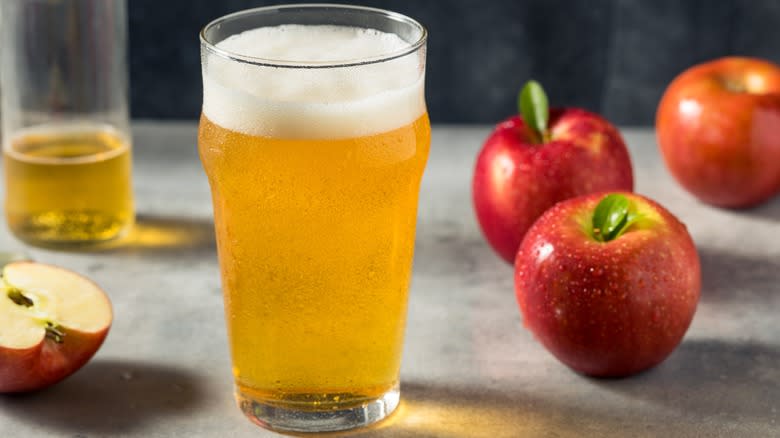
When the pilgrims first arrived in America, edible pomes probably weren't even indigenous to New England. In case you're unfamiliar, the term "pome" encompasses the family of fruits that includes apples, pears, loquats, medlars, and quinces — and the country's first foodies weren't slicing them up on a plate. Roughly 60% of all pomes grown throughout history have been used to make hard cider.
Until the late 1800s, hard apple cider was more widely accessible (and subsequently more popular) than any other alcoholic beverage in America. Even kiddos drank it in diluted form. (A technical note: In the U.S., the term "apple juice" typically refers to juiced apples with the solids filtered out, and that apple juice is fermented into "hard cider.")
Since the beginning of U.S. history, John Adams, Thomas Jefferson, William Henry Harrison, and Benjamin Franklin were all avid cider-heads. When George Washington ran for Virginia's House of Burgesses in 1758, he served voters 144 gallons of free hard cider as they stepped into the polls (and he won). Despite the image many foodies might have of John Chapman (aka the real Johnny Appleseed) as a jolly overalls-clad apple farmer, the acres of trees he planted weren't for eating — they were inedible apples that would be pressed into hard cider. Over the years, America has had a wild and whiplashing relationship with hard cider, but now it seems as though the bevy has finally made a comeback. Here's how we got there.
Read more: Canned Cocktails You'll Be Sipping All Summer
Early U.S. History And The Rise Of Apple Cider
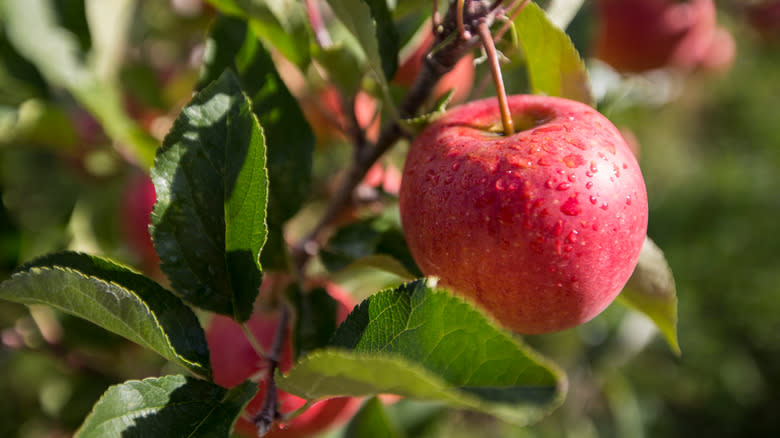
Unable to locate trees with edible fruit, the pilgrims were planting apple seeds imported from the U.K. soon after they arrived. Hops and barley proved difficult to cultivate, so if the early colonists wanted to enjoy a beer, it would have been a luxurious overseas import which required lots of money and waiting. (In the meantime, another cider, please.) Conversely, what would eventually become America's favorite fruit, apples, took well to the agricultural conditions of the Massachusetts Bay Colony. Pre-refrigeration, fermenting cider also kept it shelf-stable and safer to consume than the alternative beverage at the time: frequently contaminated drinking water. By fermenting that cider for even longer, it became apple cider vinegar, an essential tool for preserving pickled vegetables. Some households in colonial New England would down as much as 100 barrels of cider in a single winter. For a time, it was even used as currency in the trade-economic system.
In 1792, the Ohio Company of Associates set up a deal with homesteaders looking to expand into the Northwestern Territory: Folks could have 100 acres of wooded land if they agreed to plant 50 apple trees and 20 peach trees on their property as proof of permanency. Perhaps unsurprisingly, cider quickly became a huge deal for frontiersmen, who regularly drank over 10 ounces of the stuff per day.
Cider Falls Out Of Favor Around The Turn Of The 20th Century
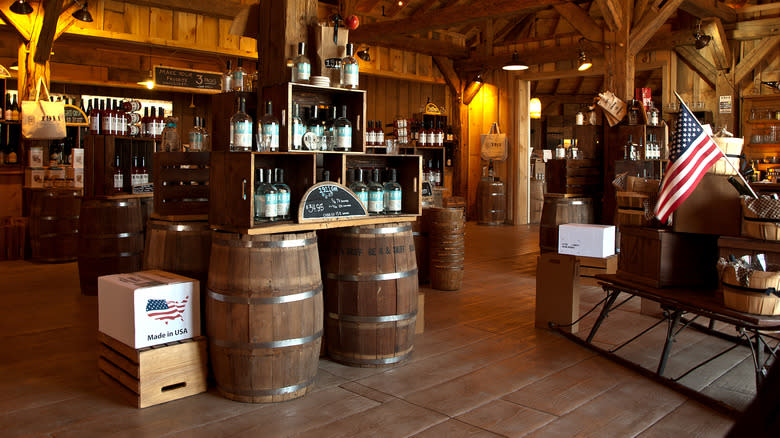
Hard cider remained popular in rural areas where coffee, tea, beer, and wine continued to be less accessible. But, when the temperance movement dedicated to moderation or abstinence in regard to alcohol swept 1800s America, farmers began chopping down cider apple trees.
By 1833, an estimated 6,000 local temperance organizations had cropped up across multiple states, and five years later Massachusetts passed the first anti-alcohol sales legislation in U.S. history. Maine followed suit in 1846. Although neither of these state laws stuck for longer than a few years, they paved the way for what would manifest as the 18th amendment to the U.S. Constitution in 1920. The Prohibition era had begun. Enter speakeasies, bootlegging, and the Mafia. The era was fueled by religious motivations and industrial bosses wanting employees to function at maximum efficiency (i.e. not intoxicated on the job). Still, Prohibition couldn't keep "spirits" down (pun intended). The period led to the creation of such enduring iconic cocktails as the Bee's Knees, Gin Rickey, Sidecar, French 75, Tom Collins, and more.
Even though Prohibition ended in 1933, the demolition of orchards full of trees isn't easy to undo. Unlike rebuilding a factory, re-growing millions of fruit-bearing trees is a many years-long process. The Industrial Revolution also spurred a mass relocation from the country to the city, meaning many orchards fell into neglect, ostensibly turning imbibers to types of alcohol that could be produced in smaller spaces.
Not Exactly A Comeback
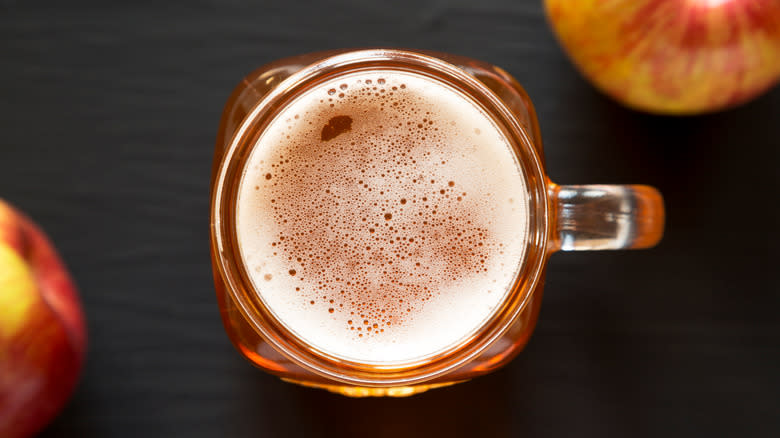
It's difficult to pinpoint exactly when or why hard cider enjoyed its resurgence in the contemporary U.S. alcohol market. But, whatever the reason, these days cider sales stretch far beyond the fall season, remaining fairly consistent year-round. November 18 is even celebrated as National Apple Cider Day. In 2022, Michelle McGrath, executive director of the American Cider Association, told Northeastern Global News that the "Cider Renaissance" began in 2010. Boston Beer Company (which also owns Sam Adams) bought 60 acres of land in New York's Hudson Valley and by 2012 it began producing Angry Orchard hard cider.
"There was a synergy of the craft beer movement, a new gluten-free trend, and an interest in local food — and you get all of those things with cider," McGrath told the outlet. Indeed, cider's comeback might have been spurred by the fashionable "regionality" appeal of local consumerism. According to a 2022 survey by the International Food Information Council, younger generations of consumers place more value on the dimensional aspects of food production like sustainability and sourcing. The cider market saw a 7% increase in 2018, and by January 2019, the U.S. was home to over 900 cider producers. In 2022 alone, Angry Orchard saw U.S. sales exceed $183 million. Total U.S. cider revenue hit a whopping $553.6 million in 2021, up from $517.8 million in 2019.
The Future Of The Cider Industry In America
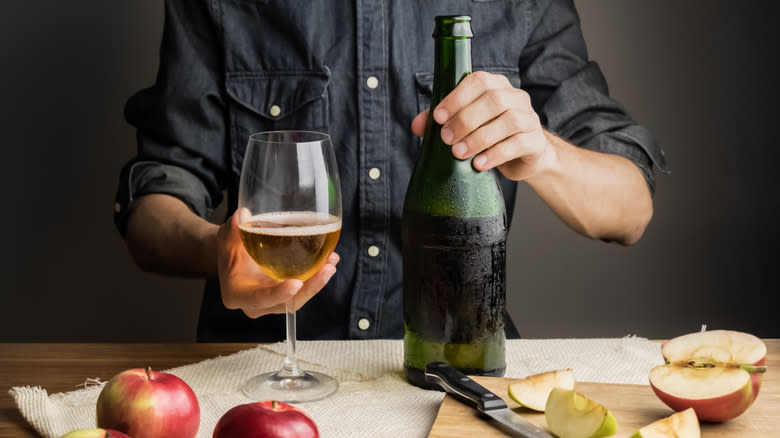
To today's discerning drinker, beer isn't the big dog on campus anymore. The U.S. alcohol market is expanding with hard seltzers and ready-to-drink canned cocktails. As consumers value a wider range of options, hard cider producers have been meeting that demand with diverse offerings from sparkling to sweet, dry, or funky. Austin Eastcider carries flavors from classic apple to rosé, pineapple, blood orange, and the ultra-dry "Texas Brut." Magners has a pear version.
Different ciders have been created to offer drastically different strengths, too. Ulee's keeps it tart and chill at 4% ABV, while Liberty Ciderworks' Manchurian Crabapple cider clocks in at 12.5%. Last fall, Angry Orchard launched an 8% cherry hard cider, a continuation of the imperial high ABV offerings that have been leading canned beverage market trends in recent years, a trend that has also encompassed beer.
Still, the higher price point might remain a deterrent for would-be hard cider fans. Most dive bars have yet to include canned ciders or hard seltzers on their Happy Hour "beer and a shot" specials, so at least for now, opting for a hard cider will likely set consumers back a little more than that thrifty Tecate-tequila combo. Even so, the North American cider sector is expected to see 3.5% growth from 2022 to 2027. (Plus, at the end of the day, some folks just don't like beer.)
Read the original article on Tasting Table.
